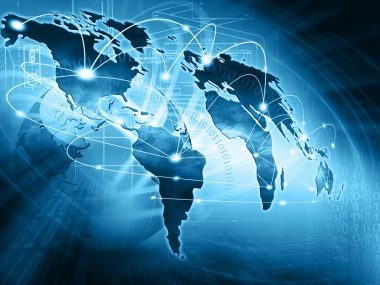Imagine taking a teenager from 2016, dropping him in 1962, and asking him to complete his daily routine. He’d be flummoxed, at best, as he realized that his ability to do countless things from one location no longer existed. For instance – He wouldn’t have one device that could both find information as well as connect it to others. He’d need to go to a library and find the information, then copy it down with a pencil and note paper. He’d then have to find some sort of transport, and physically travel to deliver that information to as many people as necessary.
It’s frustrating, to say the least, considering the technology we’re used to today, right?
Yet countless enterprises and institutions around the world are still operating like it’s 1962, despite the many opportunities to solidify their infrastructure, processes, and systems throughout their entire lifecycle, from start to finish. In other words, why aren’t companies getting with the times?
Enter Leading ICT (Information and Communication Technologies)
I spent a week in Asia recently with a company that’s helping enterprise to catch up to today and tomorrow – Huawei, the largest company about which you’re going to hear a lot more, very soon. They’ve got a unique ability to deliver Leading New ICT (LNI) to customers whose business are ICT-infrastructure driven, and to vertical solution partners or developers who are seeking an open platform or complete portfolio of ICT products and solutions, is second to none, and is continuing to be a proven strategy for enterprises worldwide.
When enterprise organizations begin to put together cloud computing, big data, SDN, the Internet of Things, and mobile broadband solutions like 5G, they start to immediately see the benefits from digital transformation, such as increased business opportunities, increased economic value, sustainability, and increased output and productivity.
Why is this important? Let’s understand how Leading New ICT is making cities smarter around the world by the examples as below.
Smart city development is emerging as a major force to tackle challenges relating to rapid urbanization in cities across the world. Progressive cities are leveraging digital technology and intelligent design to facilitate sustainability, and improve the quality of life for citizens. In other words, tech is finally coming to where you live, making your world safer and faster.
- Huawei together with MicroClinic Technologies helps Kenya to transform healthcare through telemedicine. By providing distant healthcare solutions, this Smart City solution enables county governments and hospitals in Kenya to deploy a pay-per-use model, and ensure the sustainability of healthcare services. This distant healthcare solution supported the digital transformation of Lamu’s medical system, covering 28 healthcare facilities and benefitting 200,000 people.

- Building a smart city could not only benefit the citizen but also economy as a whole. Take Dunhuang. As one of the ancient world’s most important intersections between East and West, Dunhuang is a popular city to visit on the Silk Road. In Dunhuang’s desert areas, Smart Tourism has been developed to improve the quality of services in peak seasons and attract more tourists in off-peak seasons, while promoting city governance and sustainable economic growth. That’s real money!
To achieve this, Huawei helped DSTC build a cloud center linking the service systems of government departments to provide shared information that enables a quick and efficient response to city governance issues, public security, transportation, and city management emergencies. The project involved the development of a tourist traffic model for desert areas through the Internet of Things (IoT) to improve city management, Silk Road tourism service quality and smart public services.
- Crime, terrorism, and natural disasters have seen a marked increase over the past twenty years. Governments around the world are forced to play catch-up to try and provide for the security and safety of their citizens. The price of such safety, however, has gone through the stratosphere. Protecting city residents, infrastructure, and communications is a top priority, and by utilizing Huawei’s Leading New ICT, safe city solutions, comprehensive perception, emergency command visualization and effective inter-departmental coordination can be realized, creating a three-dimensional, intelligent public safety system for a city.
By switching to a proactive environment utilizing Leading New ICT, the country of Kenya was able to create an all-in-one Safe City solution that combines call taking and dispatching, eLTE broadband trunking, video surveillance, and intelligent analysis (license plate recognition and traffic violation detection). Prior to a system such as this, maps and analysis took place in one spot, while communications and support happened in another, and of course, warnings and pre-cognition of actual events was offered on a delayed, non-real time basis, which meant that emergency services were acting in a reactive, as opposed to a proactive environment.
Devices were provided to more than 10,000 police officers, enabling full visual command. On November 26, 2015, the project ensured security during Pope Francis’ visit to the country.
These cities’ transformation wouldn’t be possible without Huawei’s understanding and vision of Leading New ICT. Yan Lida, President of Huawei Enterprise Business said “Huawei sees a Smart City is like a living being, with a brain and complex nervous system working together so that it constantly learns and enhances the physical world. Its growth and evolution depend on open platforms where all players collaborate to foster innovation.”
Why is this important to you? Think bigger picture. Connecting everything allows for better results, and companies can take a suggestion from what big cities are doing today. Huawei strives to infrastructure layers like networks, cloud computing, big data and IoT to enable cities become context aware, better connected and more intelligent. Through collaborative innovations with partners and the expertise of local developers, this ecosystem is critical to Smart City transformation.
That’s the power of Leading New Information and Communications Technology from Huawei – Leading New ICT.


Good thought
ICT technology is now so more developed in the world and there are so many people are know about this. So i think China did the great job to developed their ICT technology so more.